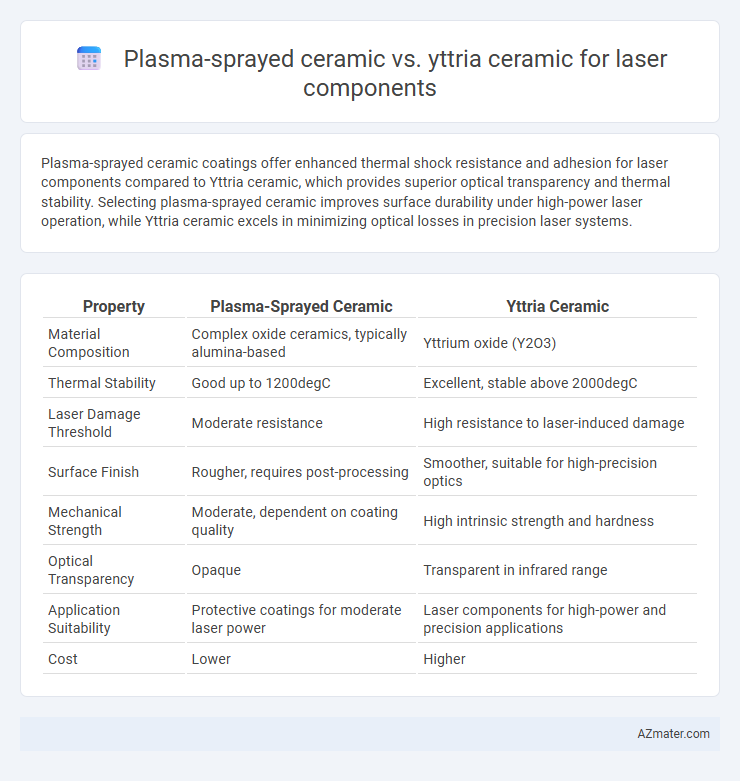Plasma-sprayed ceramic coatings offer enhanced thermal shock resistance and adhesion for laser components compared to Yttria ceramic, which provides superior optical transparency and thermal stability. Selecting plasma-sprayed ceramic improves surface durability under high-power laser operation, while Yttria ceramic excels in minimizing optical losses in precision laser systems.
Table of Comparison
| Property | Plasma-Sprayed Ceramic | Yttria Ceramic |
|---|---|---|
| Material Composition | Complex oxide ceramics, typically alumina-based | Yttrium oxide (Y2O3) |
| Thermal Stability | Good up to 1200degC | Excellent, stable above 2000degC |
| Laser Damage Threshold | Moderate resistance | High resistance to laser-induced damage |
| Surface Finish | Rougher, requires post-processing | Smoother, suitable for high-precision optics |
| Mechanical Strength | Moderate, dependent on coating quality | High intrinsic strength and hardness |
| Optical Transparency | Opaque | Transparent in infrared range |
| Application Suitability | Protective coatings for moderate laser power | Laser components for high-power and precision applications |
| Cost | Lower | Higher |
Introduction: Importance of Ceramics in Laser Components
Ceramics play a critical role in laser components due to their exceptional thermal stability, high hardness, and resistance to wear and corrosion. Plasma-sprayed ceramic coatings offer a cost-effective method to enhance surface durability and thermal insulation in laser systems, while yttria ceramics provide superior optical clarity and thermal shock resistance essential for precision laser applications. The choice between plasma-sprayed and yttria ceramics directly impacts laser performance, efficiency, and component lifespan in high-power laser environments.
Overview of Plasma-Sprayed Ceramic Coatings
Plasma-sprayed ceramic coatings provide a robust thermal barrier with excellent wear and corrosion resistance, making them ideal for laser component protection. These coatings feature a dense microstructure and strong adhesion to substrates, enhancing durability under high-power laser exposure. Yttria-stabilized ceramics, while offering superior thermal stability and optical transparency, often complement plasma spray methods for specific laser applications requiring precise thermal management.
Yttria Ceramic: Properties and Common Applications
Yttria ceramic offers excellent thermal stability, high melting point (approximately 2430degC), and exceptional electrical insulation, making it ideal for laser components requiring durability under high thermal stress. Its low thermal conductivity and resistance to thermal shock enhance performance in laser optics and protective coatings. Common applications of yttria ceramics include insulators, laser windows, and substrates in high-power laser systems where precision and thermal resilience are critical.
Thermal Stability: Plasma-Sprayed vs Yttria Ceramics
Plasma-sprayed ceramics exhibit superior thermal stability due to their dense microstructure and enhanced resistance to thermal shock, making them ideal for high-power laser components subjected to rapid temperature fluctuations. Yttria ceramics, while offering good thermal stability and high melting points, tend to have lower thermal shock resistance compared to plasma-sprayed variants, impacting their performance under intense laser irradiation. The thermal conductivity of plasma-sprayed ceramics also supports efficient heat dissipation, crucial for maintaining laser component integrity during prolonged operation.
Optical Performance in Laser Components
Plasma-sprayed ceramic coatings offer enhanced thermal stability and durability but often suffer from higher surface roughness compared to yttria ceramic, impacting optical clarity in laser components. Yttria ceramic provides superior optical transparency and lower absorption losses, making it ideal for applications requiring precise laser beam transmission and minimal scatter. Optimizing surface finish and material purity in yttria ceramics significantly improves optical performance, ensuring efficient laser energy delivery and reduced thermal distortion.
Mechanical Durability and Wear Resistance
Plasma-sprayed ceramic coatings exhibit superior mechanical durability due to their dense microstructure and strong adhesion to substrates, making them highly resistant to mechanical stresses in laser components. Yttria ceramics provide excellent wear resistance attributed to their high hardness and thermal stability, ensuring long-term performance under abrasive conditions. Combining the plasma spraying technique with yttria ceramics can optimize wear resistance and mechanical strength, enhancing the lifespan of laser system components.
Resistance to Laser-Induced Damage
Plasma-sprayed ceramic coatings exhibit higher porosity and lower density compared to yttria ceramics, resulting in reduced resistance to laser-induced damage in high-power laser applications. Yttria ceramics demonstrate superior laser damage thresholds due to their dense microstructure, high thermal conductivity, and strong chemical stability under intense laser irradiation. Consequently, yttria ceramics are preferred for laser components requiring enhanced durability and performance against laser-induced thermal and mechanical stresses.
Manufacturing Processes: Comparison and Challenges
Plasma-sprayed ceramic coatings offer a rapid, cost-effective manufacturing process with excellent thermal barrier properties but face challenges in achieving uniform thickness and porosity control for laser components. Yttria ceramics, typically produced through sintering and hot pressing, provide superior optical clarity and mechanical stability, essential for high-precision laser parts, though the process is more time-intensive and costly. Both materials demand precise control of microstructure to optimize laser performance, with plasma spraying requiring advanced parameter modulation and yttria ceramics necessitating stringent purity and densification standards.
Cost-Effectiveness and Scalability
Plasma-sprayed ceramic coatings offer a cost-effective solution for laser components due to lower material and processing expenses compared to Yttria ceramics, which require higher purity and complex fabrication methods. Scalability is enhanced with plasma spraying, enabling large-area or complex-shaped component coatings with consistent quality, whereas Yttria ceramics often face limitations in mass production due to sintering constraints and fragility. Consequently, plasma-sprayed ceramics provide a balance of economic efficiency and manufacturability, making them preferable for high-volume laser component applications.
Conclusion: Choosing the Optimal Ceramic for Laser Components
Plasma-sprayed ceramics offer superior thermal shock resistance and enhanced surface adhesion, making them ideal for laser component coatings exposed to rapid temperature fluctuations. Yttria ceramics, with their high melting point around 2430degC and excellent optical transparency in the infrared spectrum, provide exceptional durability and minimal optical losses in laser systems. Selecting between plasma-sprayed and yttria ceramics depends on the specific laser application demands, balancing mechanical robustness with optical performance to ensure optimal laser component efficiency and longevity.

Infographic: Plasma-sprayed ceramic vs Yttria ceramic for Laser component
 azmater.com
azmater.com